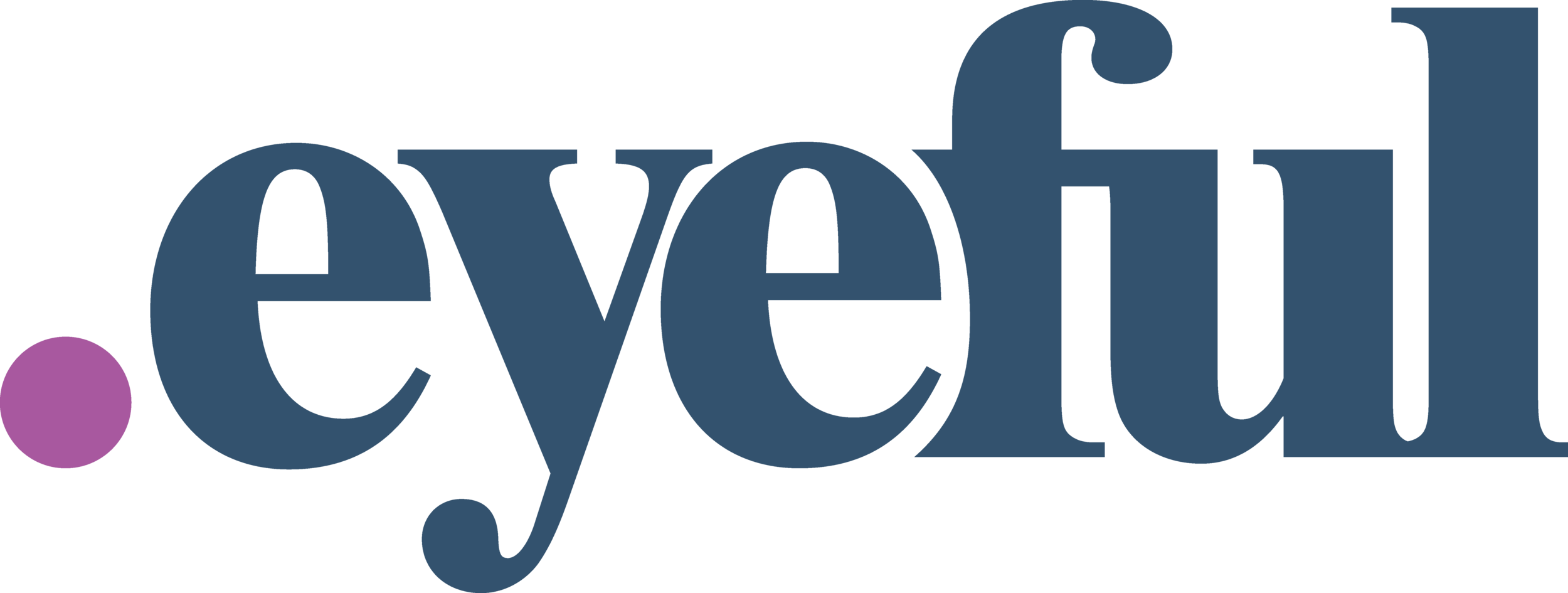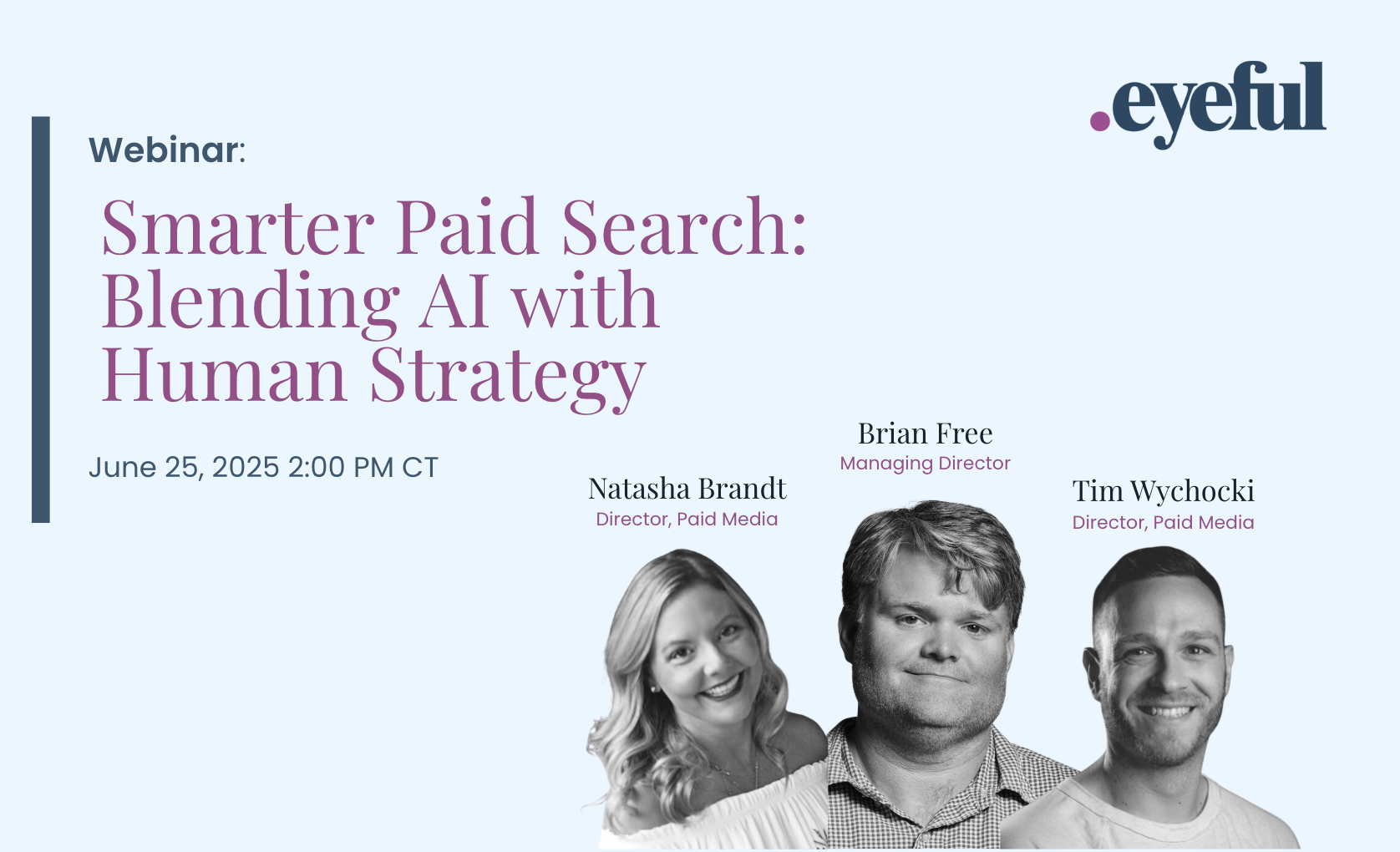The Role of AI in Your Paid Media Strategy
Artificial Intelligence is quickly becoming a major player in digital advertising. From smarter targeting to faster creative production, AI tools promise big improvements for paid media teams. But they’re not magic. Without the right inputs—and human oversight—those tools can lead your campaigns in the wrong direction.
Join the Eyeful Paid Media experts Natasha Brandt, Brian Free, and Tim Wychocki on June 25th as they host a webinar, perfect for performance marketing and GTM leaders, focusing on the integrations of AI into your paid search strategy
At Eyeful Media, we believe AI works best when it supports, not replaces, human expertise. We asked our paid media team to share how they’re using AI today, where it helps the most, and where caution is still needed.
Here’s what they had to say.
Data Is the Fuel for AI Success
Before AI can make smart decisions, it needs smart data. That’s why first-party data, thoughtful segmentation, and event tracking are critical pieces of any paid media strategy.
“Leverage your first-party data as the foundation for AI optimization,” says Jordan Coon. With platforms like Google Ads shifting toward privacy-first models, clean, consented customer data from CRMs, websites, and offline sources becomes even more valuable. It helps AI target more accurately, build stronger lookalike audiences, and spend your budget more efficiently.
Bill Caton adds a layer of nuance: “Consider where segmentation is strategic and where it’s unnecessary.” AI tools perform better with larger data sets, but that doesn’t mean every segment is useful. Sometimes, it’s smarter to simplify.
And as Ty Anderson puts it, “Any system is only as good as the data it’s using.” AI can’t fix broken or incomplete data. By tracking value-based events and feeding systems high-quality inputs, you give AI what it needs to actually work.
Bottom line: Better data equals better results. AI is powerful—but only when it has the right fuel.
Creative Still Needs a Human Touch
AI can speed up the creative process, but it can’t fully replace the human eye—or ear. When it comes to messaging, tone, and visuals, human oversight is still essential.
“Don’t rely on AI-generated copy without human oversight,” warns Emily Iten. While AI can crank out headlines and body text in seconds, it often misses the subtle tone or brand personality that connects with real people. Reviewing and refining AI copy ensures your message stays on-brand and impactful.
Tyler Laco sees potential in AI visuals—but urges a cautious approach: “Incrementally test into AI-generated creative to help build your library.” For brands without professionally produced assets, AI tools can help fill the gaps. They make it easier to explore new formats and platforms—but only if you stay in control of what’s being created and why.
Simona Greenberg reminds us not to get too comfortable with AI’s creative suggestions: “Always question the why behind AI recommendations—especially when they affect how your brand is seen.” AI can help optimize for performance, but only you know what makes sense for your brand.
AI can help you create more, faster—but the final word should always be yours.
Strategy Shouldn’t Be Automated
AI can crunch numbers and find patterns, but it doesn’t understand your brand's bigger picture. That’s why strategy should stay in human hands.
“AI isn’t going to understand your brand tone, long-term goals, or when you need to pivot,” says Natasha Brandt. Maybe you’ve got a product launch on the calendar, or a competitor just dropped a flash sale. AI doesn’t see the market the way you do—and it certainly doesn’t read the room.
Amy Lundstram adds, “AI recommendations often prioritize short-term performance metrics.” That might help your ROAS in the moment, but it doesn’t always serve your brand’s long-term health, values, or positioning.
When building your paid media strategy, think of AI as an assistant—not a decision-maker. It can guide performance, but only humans can guide purpose.
AI Needs Guardrails and Guidance
AI doesn’t run on autopilot—it needs direction. Left unchecked, it might optimize toward the wrong goals or make decisions that don’t align with your strategy.
“Don’t just set it and forget it,” says Tim Wychocki. AI tools need a steady stream of inputs: updated data, fresh creative, refined audience lists, and clear performance targets. They also need boundaries—like exclusions or ROAS limits—to make sure they’re working toward what matters most.
Simona Greenberg echoes this point: “Always question the why behind AI recommendations.” Even when an algorithm suggests something that looks smart on paper, it’s up to you to double-check it. Determine whether it actually makes sense for your campaign and your brand.
Think of AI as a talented intern. It can handle a lot—but only if you’re guiding it every step of the way.
Use AI to Spark New Ideas
While AI isn’t a strategist, it can be a great brainstorming partner. With the right prompts, it can surface new directions you might not have considered.
“Use AI to discover new audience targeting ideas,” suggests Matthijs Roobol. Whether it’s uncovering interests, behaviors, or job titles you hadn’t thought to target, AI can widen your lens and inspire new campaign strategies. Even if you don’t use every suggestion, the process itself can lead to valuable insights.
When you use AI for ideation, it becomes a tool for creativity—not just optimization.
Bringing Balance to Your Paid Media Strategy
AI has a growing role in paid media, but it’s not here to take over. When paired with strong data, human oversight, and strategic thinking, it can help your campaigns perform better and scale faster. But like any tool, its value depends on how you use it.
At Eyeful Media, we don’t hand over the reins—we guide AI with experience, context, and creativity.
Want help building a paid media strategy that blends smart tech with human insight? Let’s talk.
Join the Eyeful Paid Media experts Natasha Brandt, Brian Free, and Tim Wychocki on June 25th as they host a webinar, perfect for performance marketing and GTM leaders, focusing on the integrations of AI into your paid search strategy

